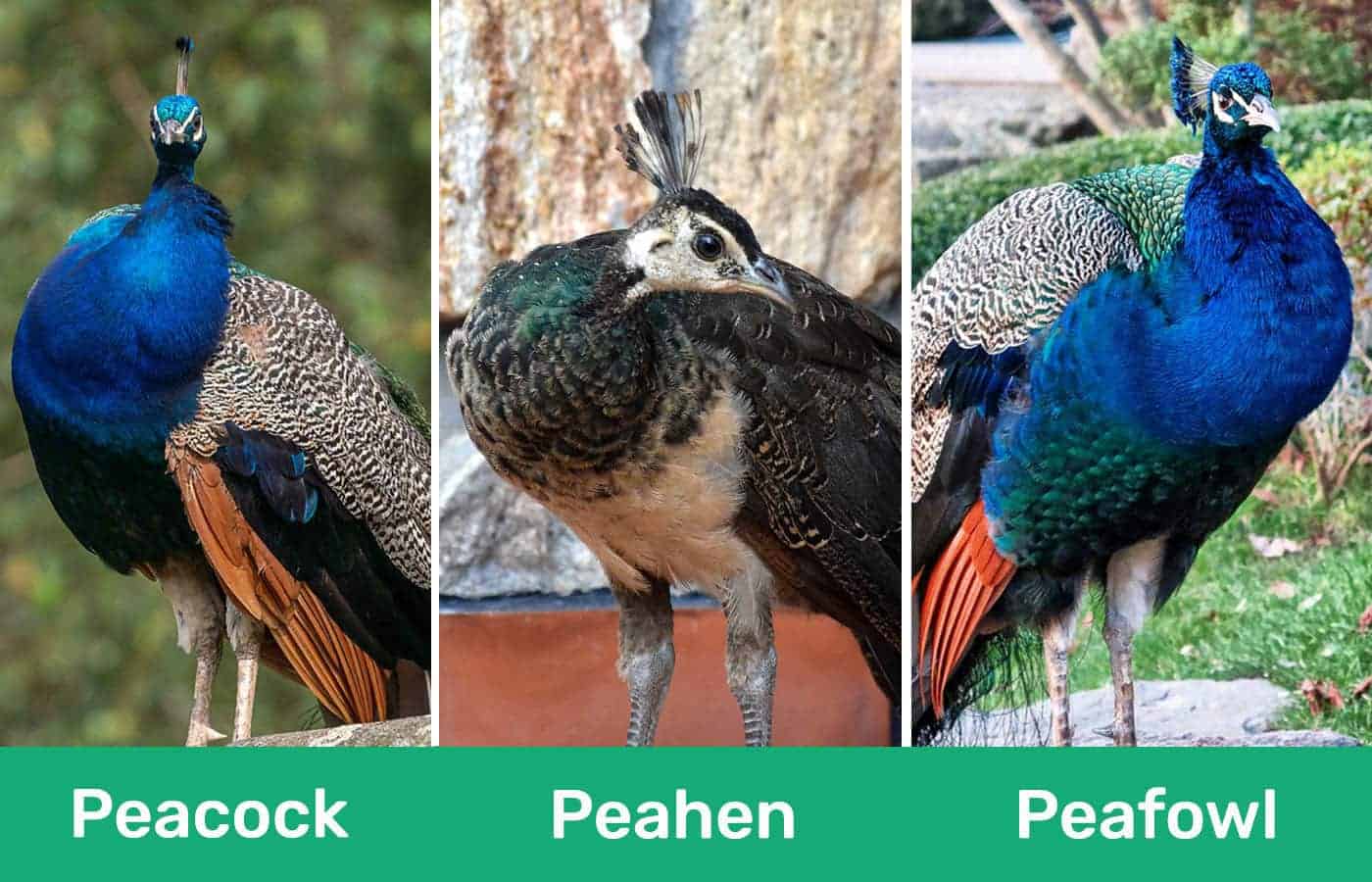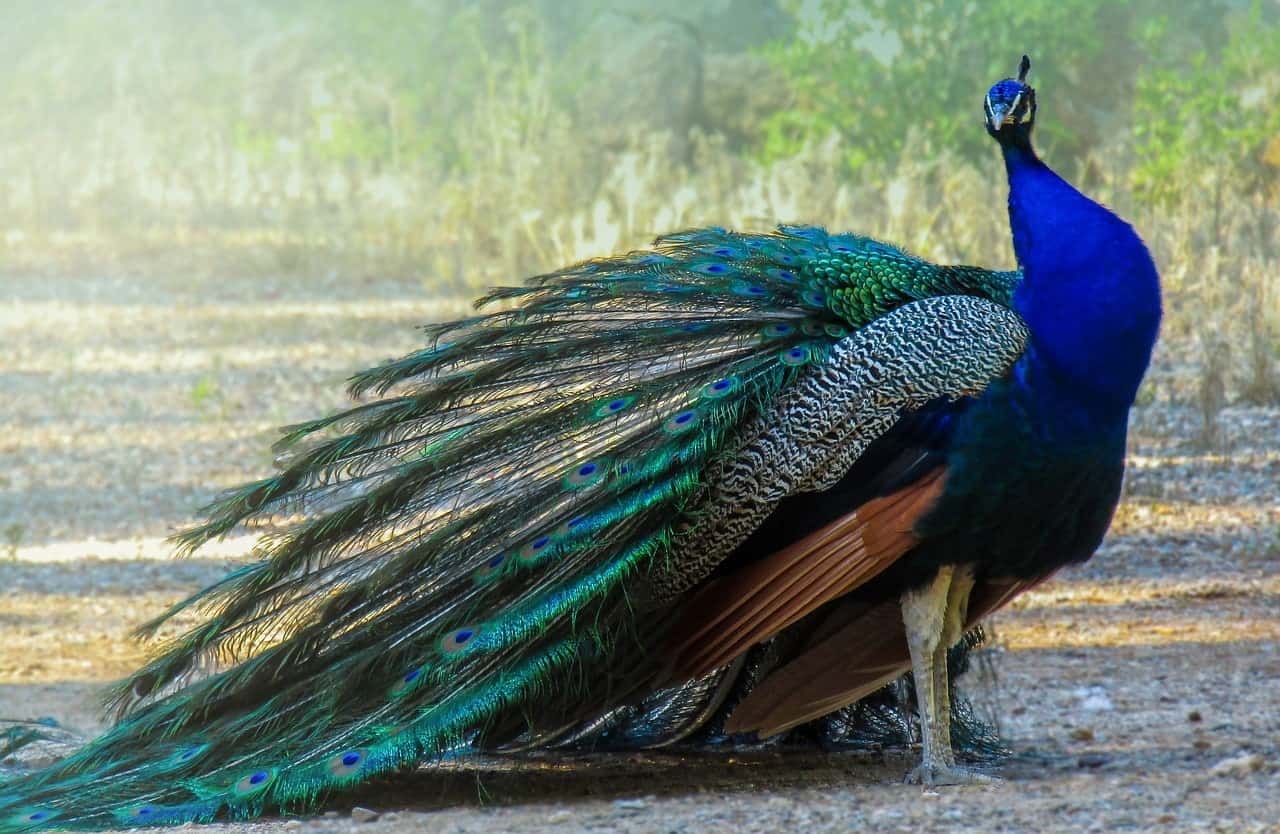Perhaps you’re thinking of adding some fowl to your homestead, or maybe you just want to know the difference between a peacock, a peahen, and a peafowl. Either way, you’ve come to the right place.
The truth is that both the peacock and the peahen are peafowl. The term peacock refers to a male peafowl, and a peahen is a female one. But while that’s the general difference between a peacock, a peahen, and a peafowl, the list doesn’t stop there.
We decided to break down everything that you need to know about these birds for you here.

Visual Differences

At a Glance
- Origin: Asia
- Size: Up to 90 inches long, 46 inches tall, 9 to 13 pounds
- Lifespan: 10 to 25 years
- Domesticated?: Rarely
- Origin: Asia
- Size: 39 to 45 inches long, 38 inches tall 6 to 9 pounds
- Lifespan: 10 to 25 years
- Domesticated?: Rarely
- Origin: Asia
- Size: 39 to 90 inches long, 38 to 46 inches tall, 6 to 13 pounds
- Lifespan: 10 to 25 years
- Domesticated?: Rarely
Peacock Overview

A peacock is a male peafowl, but what exactly does that mean? Do they look any different than a peahen, and is there any reason that you should bring one to your home? We break it all down for you here.
Characteristics & Appearance
Since peacocks display their colorful trains as a part of their mating ritual, they’re the peafowl that you typically think of when you picture them in your head. Still, while the term “peacock” is sometimes used synonymously with the rest of the breed, the truth is that only a male peafowl is called a peacock!
The peacock has a few more distinctive traits outside of their colorful train. First, they tend to be significantly larger than peahens. A peacock can reach up to 90 inches in length and reach a height of 46 inches.
Despite a tail length that can reach near 7 ½ feet, the most that an average peacock weighs is 13 pounds. They’re still larger than a peahen, but far from a heavy bird.
Uses
There are not many domestic uses for a peacock. In fact, there are only about three ways that you can utilize them. First, you can use a peacock to breed them with a peahen. This gives you more peafowl altogether, so if you’re interested in breeding peafowl, you’ll need at least one peacock.
Second, peacocks do a great job at controlling pests and other small insects. These are their natural food source, so if you’re having a problem in your garden, a peacock can help get everything under control.
Finally, you can eat the peacock. Peacock isn’t a widespread food option, but there are enough people who want to eat them that you can find a market if you’re raising peacocks for food.

Peahen Overview
While peacocks are male peafowl, peahens are the female ones. Of course, this means peahens can lay eggs, but what else do you need to know about the peahen, and is one right for your homestead? We break down everything that you need to know about them here.

Characteristics & Appearance
While a peacock has a super colorful tail to admire, a peahen tends to be rather drab. They don’t have that signature train, and they tend to be significantly shorter.
A peahen has an average length between 39 and 45 inches long, and they stand about 38 inches in height. While you might think that a 3-foot bird would have some weight, the average peahen only weighs between 6 and 9 pounds!
Uses
While you can use a peahen for egg production, the truth is that the average peahen only lays about 20 eggs per year. This makes them a poor choice for egg production, especially when you consider that a chicken can lay up to 250 eggs in a year!
But while peahens are significantly smaller than peacocks, they generally produce a similar amount of meat if you’re raising them for consumption. Most of the size and weight difference between the two comes down to the peacock’s colorful train, and you’re not eating that, anyway.
Peahens can also act as good pest control animals because they eat insects and grubs that could otherwise infest your homestead. However, keep in mind that peahens will also tear apart plants and other vegetation, which can be a notable drawback.
What Are the Differences Between Peacocks, Peahens & Peafowls?
The easiest way to break it all down is that a peacock is a male peafowl, and a peahen is a female one. Both sexes are peafowl.
You can always tell the difference between a peacock and a peahen simply by looking at the tail. Peacocks have colorful feathers that they show off in the mating process, while peahens look drab and dull in comparison.
The only other real difference between a peacock and a peahen is the size. Peacocks are significantly larger than peahens, especially when it comes to length. This mainly comes down to the size of their train, but even so, a male peacock can reach twice the length of a peahen. They tend to stand about 5 to 7 inches taller too.
- You may also like: How Long Do Peacocks Live? (Average Lifespan Data & Facts)

Which One Is Right for You?
If you’re interested in adding peafowl to your homestead, there’s not much of a difference between a peahen or a peacock. It all comes down to whether you care about the colorful train and how much space you have.
If you’re tight on space, the peacock’s long train can make things even tighter, so a peahen might be the way to go, even though they don’t have the same colorful appearance as the peacock.
Of course, if you’re looking to breed peafowl, you’ll need both a peacock and a peahen, so you might end up with both either way!
Featured Image Credit: Pixabay
